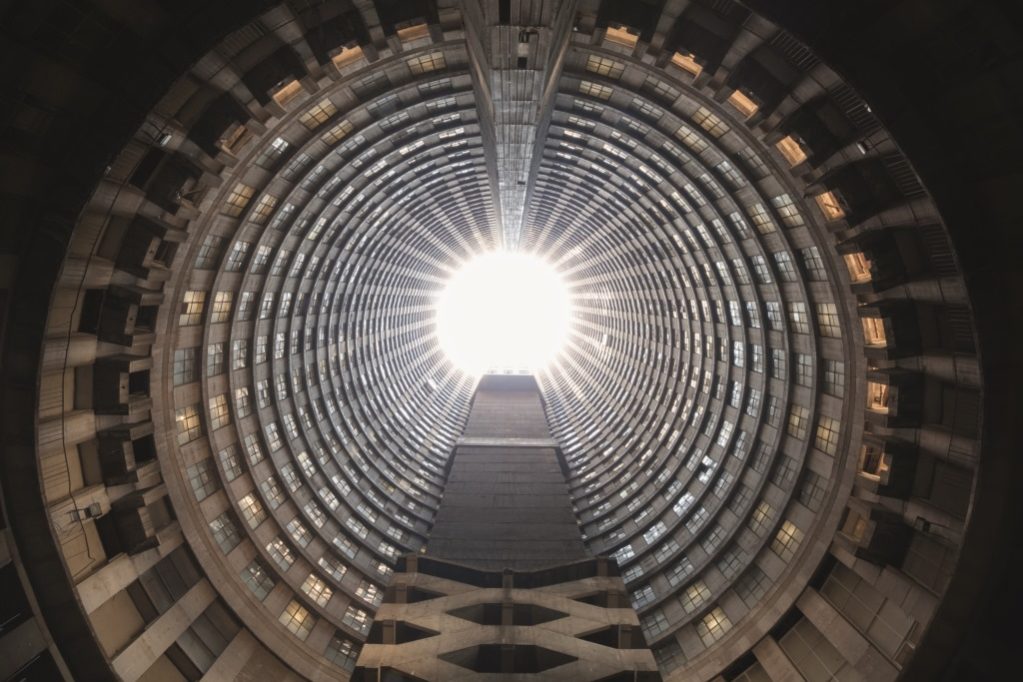Rising 54 stories above Johannesburg’s bedrock is the concrete cylinder of the Ponte building. It’s a statement on the skyline, it’s also the tale of the rise and fall and rise again of the city’s most neglected suburb.
In its 2014 incarnation, Ponte is testament to calculated risk, follow-through and good timing.
Owned by the Kempston Group, the building is an asset that’s beginning to make economic sense after more than 15 years of being a write-off.
Ponte started life in 1975 as one of the Johannesburg flatlands’ most sought after locations. It remains the tallest residential building in Africa. The views from the Hillbrow ridge were resplendent and the curves that architect Manfred Hermer could coax out of concrete were irresistible.
In the 1960s, Hillbrow—an inner-city residential neighborhood housed foreign white professionals lured by the apartheid government. These migrants from Europe and Britain sought the lock and go life of apartment living and the convenience of central Hillbrow. They gave Hillbrow its bohemian twist and helped make it a suburb that thumbed its nose at apartheid’s segregationist laws.
Loading...
Bumpy times lay ahead though. One year after Ponte opened its doors, the 1976 Soweto uprising changed South Africa forever. The economic boom years had also peaked. A subsequent mass white exodus to the suburbs skewed the supply and demand in the Hillbrow real estate market. By the mid-1990s, Ponte itself had shifted from rundown to outright slum.
Sultan Ndabagobetse is a Burundi immigrant who arrived in South Africa in 1996 and has lived in Ponte on and off since 1999.
“Those early days were really bad; they could rob you inside your flat. Ponte was dirty and not safe,” he says.
Hillbrow became a forbidden zone for polite, white, middle-class South Africa. It became part myth, part true horror of crime, drug dens, prostitutes and urban decay. For thousands though, especially a new wave of African migrants who had arrived since 1994, these Johannesburg flatlands represented cheap accommodation in the city’s economic heart.
Ndabagobetse left Ponte in 2001 but returned in 2004.
“I have lived there ever since; even through the renovations. It is more expensive now, but I work hard so I can live there. There aren’t other places that are that safe in Hillbrow. I have three children today and for now I can say Ponte is good for us,” says Ndabagobetse, who owns a car dealership in the city center.
Hillbrow is no stranger to ephemeralness, or to making room for those prepared to try again. Ponte was in the right place.
The years of 2006 and 2007 marked the ‘New Ponte’ era. New Ponte developers struck a deal with Kempston; a reported R200 million ($18.6 million) would be sunk into transforming the tattered building into upmarket units. The ambitious plans tanked. The building, stripped in anticipation of fresh development, stood vulnerable to opportunistic plunderers.
Jason Kruger, the financial manager at Kempston, says by 2009 it was decision time.
“We had a broken building. We could either offload it in its current state, knowing we’d get nothing for it, or we could fix it and build on its value as a building with visual prominence and legacy,” he says.
Kruger won’t disclose the exact amount spent on the building but says it was a bold gamble and took tens of millions and just under two years to complete the initial renovation phase.
“We have built about two to three specs higher for this rental range and a lot of money was spent on new lifts and security,” he says.
They also decided on in-house building management. It was key to tightening up control. Ponte’s manager Ria Breedt, who lives in the building with co-manager and husband Jaap, says Ponte hits the mark by shoring up the basics of security, cleaning and collective buy-in on rights and responsibilities.
Strict tenant rules apply. There are random flat inspections and the biometric security system can seem heavy.
“Tenants understand these measures are important for their safety and to make sure things run properly,” says Breedt.
The next step for Kempston is further development of the commercial floor. There are anchors like a laundry, supermarket and internet café with plans for doctors’ rooms, a day-care center and a restaurant.
The 484 apartments are rental-only, for better control, says Kruger. There’s a mix of single bedroom apartments through to luxury three-bedroom suites in the upper levels. The starting rental price, which includes a deposit, is R4,000 ($372) and goes up to around R9,600 ($890) a month. There is almost full occupancy.
South African Ndanga Phalamdwa, who was born in the country’s northern province of Limpopo, has lived in Ponte since 2009. He saw it as a place to stay, since he arrived in Johannesburg in 2003.
“The structure of the building attracts you, you see Ponte wherever you are in the city,” he says.
Most remarkable for Ponte is that in the last few years it has been able to attract white tenants. It’s significant because the racial demographic of inner-city Joburg, has for decades, resembled the old days of statutory segregation.
Ponte also timed its revival well and is riding the current ‘hipster’ wave. The rise of this young, multi-racial, relatively moneyed aspiring professional class represents a powerful new consumer force. Part of their preference is for crisp, cool and clever alternatives to suburban life.
Ponte has seen it all – the whims, wishful thinking and real wonder – and it has stood firm. Ndabagobetse calls Ponte a reference point; sometimes he sends postcards to his sister who fled Burundi to settle in France. The photo on the front is usuallyJohannesburg’s skyline. And there, dead center, stands the cylindrical certainty of Ponte.
Loading...
